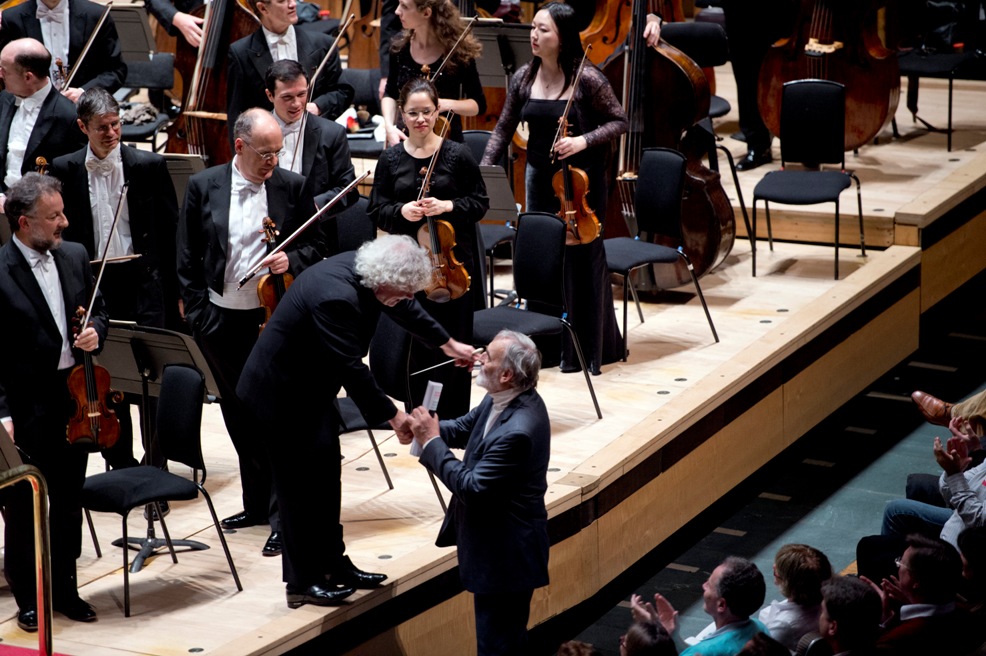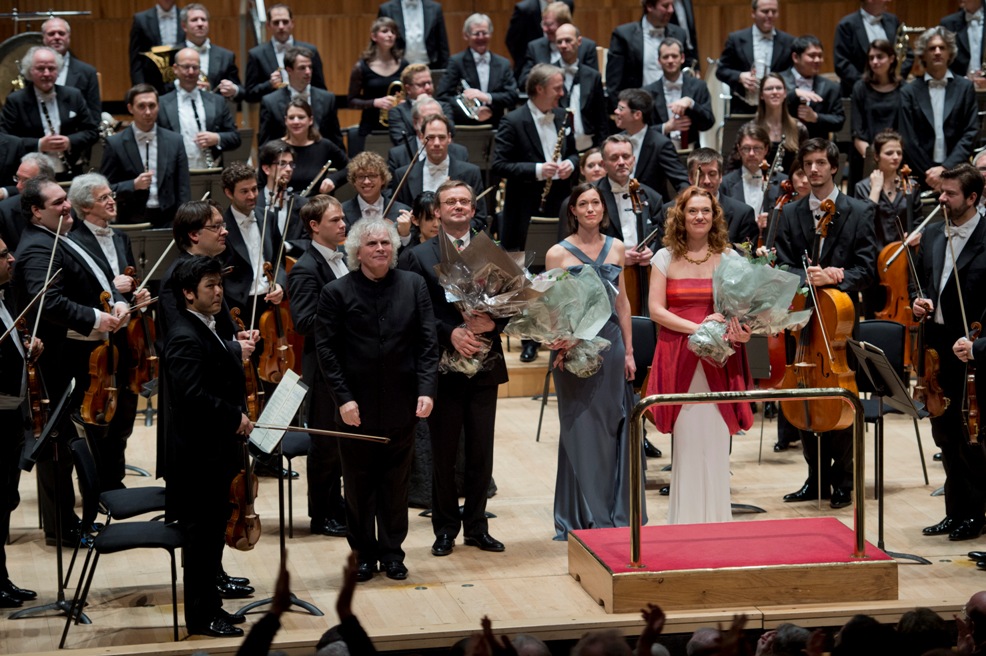Kožena, Royal, Berliner Philharmoniker, Rattle, RFH | reviews, news & interviews
Kožena, Royal, Berliner Philharmoniker, Rattle, RFH
Kožena, Royal, Berliner Philharmoniker, Rattle, RFH
Rattle's London residency closes more or less on a high
It’s all over: the final note of the Berliner Philharmoniker’s London Residency, for which many music-lovers bought tickets about a year ago, has risen into the ether, leaving most questions concerning Sir Simon Rattle’s future plans as yet unanswered.
On the final day the 12-strong cello section, which has an independent life, gave a lunchtime concert; and in the afternoon Sir Simon led a mixed-ability assemblage of young players from all over London – the Young Orchestra for London – in a free concert in the Clore Ballroom. I spoke to a young musician who has been working with them, according to whom they had come on in leaps and bounds during their rehearsals and loved every moment of the experience, with musical results far exceeding expectation. It shows what can happen when you allow youngsters to aim for the stars, then put one in front of them. Let’s hope Sunday might prove a beginning for them, rather than an end in itself.
 The Berliners’ final concert launched with a curtain-raiser by Helmut Lachenmann; the German composer this year celebrates his 80th birthday. His Tableau for Orchestra of 1988-89 offers a soundscape akin to an acoustic form of musique concrête: an assemblage of evocative sounds predicated to resemble the rustling, thudding, whirring and expectant silences of the natural world – hence the connection with Mahler’s Second Symphony. If those allusions might well have passed the audience by without the explanatory programme note, the piece – which is much of its time – was colourfully performed and warmly welcomed, as was the composer himself, his lanky figure unmistakable in the stalls (pictured above, first of two images by Monika Rittershaus) and towering over Rattle on the platform.
The Berliners’ final concert launched with a curtain-raiser by Helmut Lachenmann; the German composer this year celebrates his 80th birthday. His Tableau for Orchestra of 1988-89 offers a soundscape akin to an acoustic form of musique concrête: an assemblage of evocative sounds predicated to resemble the rustling, thudding, whirring and expectant silences of the natural world – hence the connection with Mahler’s Second Symphony. If those allusions might well have passed the audience by without the explanatory programme note, the piece – which is much of its time – was colourfully performed and warmly welcomed, as was the composer himself, his lanky figure unmistakable in the stalls (pictured above, first of two images by Monika Rittershaus) and towering over Rattle on the platform.
The refurbished acoustic here seems to put clarity ahead of warmthAnd so to Mahler. It’s a deceptive piece, the good old "Resurrection" Symphony. Some elements of it are so long-winded, neurotic and flustered that it can provoke the idea that the composer needed to meet Doktor Freud some years before he actually did; yet at its most magnificent it can leave no listener unstirred. The Berliner Philharmoniker, who must have been fairly exhausted after such an intense week, pulled out all the stops for it. This is an orchestra of zealots for sound, in which every member seems to give 200 percent every night in pursuit of their specific ideal – which they frequently attain.
Perhaps that task is more difficult in the Royal Festival Hall, where everything is audible loud and clear. The refurbished acoustic here seems to put clarity ahead of warmth; every cough or sniff becomes a part of the sonic canvas, together with every tooth-curling plastic squeak of sweet wrapper and every turn of programme page of puzzled punters hunting – fruitlessly in this case – for a translation of the symphony’s words. The desired blend and bloom of tone are lacking and while every little slip of ensemble comes across in minute detail, the radiance that surrounds a great orchestral sound is hard indeed to evoke. This performance, mainly fine though it was, could have made a still finer impression in the Berlin Philharmonie.
It certainly had its great moments. The massed forces of the London Symphony Chorus and the City of Birmingham Symphony Chorus were in magnificent form, the first entry breathtakingly soft, the climaxes suitably roof-raising. Magdalena Kožena (aka Lady Rattle) brought a dusky, bronzed tone to the fourth movement, "Urlicht"; she and the soprano Kate Royal (pictured below with Kožena and Rattle in the line-up) sang from the back of the stage, just behind the first violins, a placing that enabled them to be a crucial part of the picture without dominating it excessively. Royal’s tone, slenderer in nature than Kožena’s, suited the ethereal hints of the music well, though perhaps the two made rather an odd vocal couple.

Rattle, as in the Sibelius cycle, seemed at his finest in terms of pacing; his skill with the plentiful gear-changes, swinging the giant orchestra round the twists and turns of Mahler’s mountainous roads as one, and his ability to pace the great crescendos and outbursts (nought to 90 in 20 smooth seconds), stirred and compelled every time.
The fury and passion of the opening possessed a positively Wagnerian tension; though if Mahler in his opening movement regards the matter of life as “a huge, awful joke”, any hints of black humour were few and far between. The deceptive, lilting dance of the second movement was beautifully judged in tempo and balance; the third movement, though, could perhaps have benefitted from more bite, more Mephistophelian mischief; and there was a moment of dangerous dislocation at which one feared a breakdown, physical rather than spiritual, was brewing. Fussy Mahlerians would probably have hankered for more emotional facets to be highlighted in the symphony’s processes, with darker, sharper, crueller shades mixed in to the sonic kaleidoscope – which at times verged on being simply too nice.
For the closing pages, though, Rattle more or less unleashed the orchestra and let them do what they do best: making that unbelievably glorious noise. And the audience was crazy for it.
rating
Share this article
The future of Arts Journalism
You can stop theartsdesk.com closing!
We urgently need financing to survive. Our fundraising drive has thus far raised £49,000 but we need to reach £100,000 or we will be forced to close. Please contribute here: https://gofund.me/c3f6033d
And if you can forward this information to anyone who might assist, we’d be grateful.

Subscribe to theartsdesk.com
Thank you for continuing to read our work on theartsdesk.com. For unlimited access to every article in its entirety, including our archive of more than 15,000 pieces, we're asking for £5 per month or £40 per year. We feel it's a very good deal, and hope you do too.
To take a subscription now simply click here.
And if you're looking for that extra gift for a friend or family member, why not treat them to a theartsdesk.com gift subscription?
more Classical music
 theartsdesk at the New Ross Piano Festival - Finghin Collins’ musical rainbow
From revelatory Bach played with astounding maturity by a 22 year old to four-hand jazz
theartsdesk at the New Ross Piano Festival - Finghin Collins’ musical rainbow
From revelatory Bach played with astounding maturity by a 22 year old to four-hand jazz
 Kanneh-Mason, Britten Sinfonia, Shave, Milton Court - a grin and a big beaming smile
A pair of striking contemporary pieces alongside two old favourites
Kanneh-Mason, Britten Sinfonia, Shave, Milton Court - a grin and a big beaming smile
A pair of striking contemporary pieces alongside two old favourites
 First Person: Manchester Camerata's Head of Artistic Planning Clara Marshall Cawley on questioning the status quo
Five days of free events with all sorts of audiences around Manchester starts tomorrow
First Person: Manchester Camerata's Head of Artistic Planning Clara Marshall Cawley on questioning the status quo
Five days of free events with all sorts of audiences around Manchester starts tomorrow
 Goldscheider, Brother Tree Sound, Kings Place review - music of hope from a young composer
Unusual combination of horn, strings and electronics makes for some intriguing listening
Goldscheider, Brother Tree Sound, Kings Place review - music of hope from a young composer
Unusual combination of horn, strings and electronics makes for some intriguing listening
 theartsdesk Q&A: composer Donghoon Shin on his new concerto for pianist Seong-Jin Cho
Classical music makes its debut at London's K-Music Festival
theartsdesk Q&A: composer Donghoon Shin on his new concerto for pianist Seong-Jin Cho
Classical music makes its debut at London's K-Music Festival
 Helleur-Simcock, Hallé, Wong, Bridgewater Hall, Manchester review - moving lyricism in Elgar’s concerto
Season opener brings lyrical beauty, crisp confidence and a proper Romantic wallow
Helleur-Simcock, Hallé, Wong, Bridgewater Hall, Manchester review - moving lyricism in Elgar’s concerto
Season opener brings lyrical beauty, crisp confidence and a proper Romantic wallow
 Kohout, Spence, Braun, Manchester Camerata, Huth, RNCM, Manchester review - joy, insight, imagination and unanimity
Celebration of the past with stars of the future at the Royal Northern College
Kohout, Spence, Braun, Manchester Camerata, Huth, RNCM, Manchester review - joy, insight, imagination and unanimity
Celebration of the past with stars of the future at the Royal Northern College
 Jansen, LSO, Pappano, Barbican review - profound and bracing emotional workouts
Great soloist, conductor and orchestra take Britten and Shostakovich to the edge
Jansen, LSO, Pappano, Barbican review - profound and bracing emotional workouts
Great soloist, conductor and orchestra take Britten and Shostakovich to the edge
 Jakub Hrůša and Friends in Concert, Royal Opera review - fleshcreep in two uneven halves
Bartók kept short, and a sprawling Dvořák choral ballad done as well as it could be
Jakub Hrůša and Friends in Concert, Royal Opera review - fleshcreep in two uneven halves
Bartók kept short, and a sprawling Dvořák choral ballad done as well as it could be
 Hadelich, BBC Philharmonic, Storgårds, Bridgewater Hall, Manchester review - youth, fate and pain
Prokofiev in the hands of a fine violinist has surely never sounded better
Hadelich, BBC Philharmonic, Storgårds, Bridgewater Hall, Manchester review - youth, fate and pain
Prokofiev in the hands of a fine violinist has surely never sounded better
 Monteverdi Choir, ORR, Heras-Casado, St Martin-in-the-Fields review - flames of joy and sorrow
First-rate soloists, choir and orchestra unite in a blazing Mozart Requiem
Monteverdi Choir, ORR, Heras-Casado, St Martin-in-the-Fields review - flames of joy and sorrow
First-rate soloists, choir and orchestra unite in a blazing Mozart Requiem
 Cho, LSO, Pappano, Barbican review - finely-focused stormy weather
Chameleonic Seong-Jin Cho is a match for the fine-tuning of the LSO’s Chief Conductor
Cho, LSO, Pappano, Barbican review - finely-focused stormy weather
Chameleonic Seong-Jin Cho is a match for the fine-tuning of the LSO’s Chief Conductor

Add comment